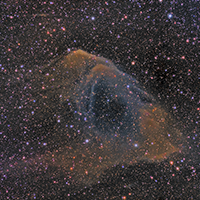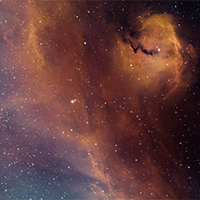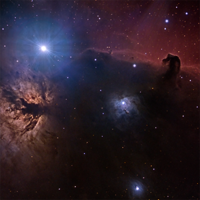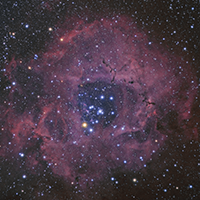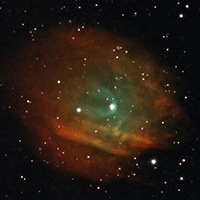Tagged: Sh2
29-Sep-2022
When stars like the Sun are near end of life, they send their outer layers into space to create glowing clouds of gas, a planetary nebulae. This ejection of mass is uneven, and planetary nebulae can have complex shapes. This dying star is moving rapidly through space, resulting in a long tail of ionized hydrogen gas.
30-Mar-2022
Although categorised as a hydrogen emission nebula, Sh2-63 lacks the bright red colouring typical of similar objects.
12-Feb-2019
The Skull & Crossbones Nebula is an active star-forming region approximately 20,000 light years away.
19-Jan-2017
The Seagull Nebula a region of nebulosity that lies 1820 light years away, along the border between the constellations Monoceros and Canis Major. It includes the neighboring regions of star clusters, dust clouds and reflection nebulae centered around IC 2177.
04-Jan-2017
Adjacent to the bright blue supergiant star Alnitak shines the ionised hydrogen of the Flame and Horsehead nebulae.
19-Jul-2018
Shaped like a cats paw, NGC 6334 is a stellar nursery and emission nebula 5,500 light years away in the constellation Scorpius. This image comprises of emission line data for Sulfur-II, Hydrogen-alpha and Oxygen-III, mapped to red, green, and blue respectively.
21-Jan-2018
The Rosette Nebula is an emission nebula 3000 light years away. The central area of the nebula contains an open cluster of hot, blue stars which have cleared much of the center of its gas.
17-Aug-2017
Sh2-37 is a hydrogen emission nebula with two small blue reflection nebulae, embedded in a dusty background against the core of the Milky Way.
16-Jun-2016
Narrowband images are rarely presented as true color light. When imaging in narrowband, colors are assigned to each channel based on the specific emission lines captured. One of the most common choices is the SHO Hubble Pallet, but the choices for mixing colors are endless. Here are 9 examples of how an image of a planetary nebula may be colored.
10-May-2016
For my first foray into narrowband imaging, I have chosen a very dim & difficult target: planetary nebula Sh2-313, also known as Abell 35 and PK 303+40.1

